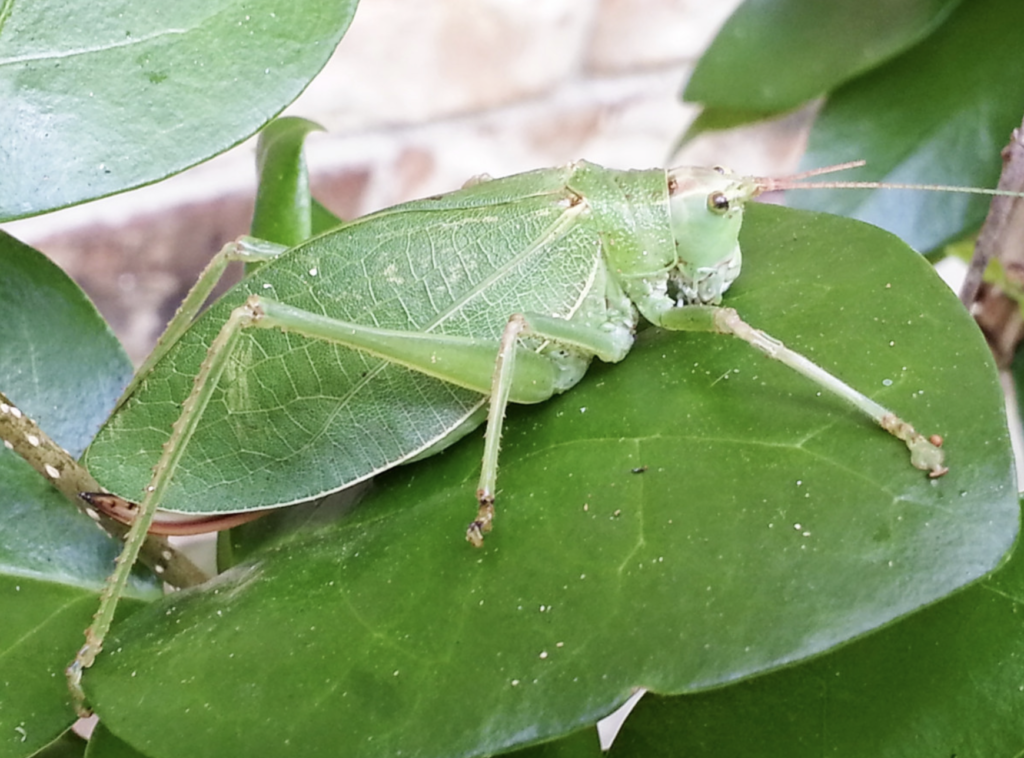Almanac: Summer Songs

Summer music-maker Pterophylla camellifolia, the common true katydid. Photo: Creative Commons
A friend and I were sitting on her front porch after one of those unbearably hot days last week enjoying the hay-scented breeze. It wasn’t actually hay—it was her desiccated lawn—but it was still lovely and the air felt soft against the skin, rather than oppressive. The stars were coming out, brightening as a waxing yellow moon set in the west, and the usual biting insects were absent, so we decided to forego the AC and make the backyard our bedroom.
In addition to the marvels of the sky (complete with some early meteors probably related to the annual Perseid meteor shower) we were serenaded by both crickets and katydids, two of the three major summer insect music-makers, the third being cicadas. Once you learn their songs, you can tell these critters apart easily enough, but you can also tell who’s doing the singing by noting when you’re hearing them, and where the sound is coming from. Cicadas sing from trees during the day, and usually only on very hot days. Katydids sing from the trees, too, but only at night, with a distinctive, scratchy three-or-four note song that their name is supposed to mimic: kay-tee-did, kay-tee-didn’t, kay-tee-did, kay-tee-didn’t. Crickets also sing at night, but they don’t climb trees, so their music is usually coming from the ground or very low bushes.
Crickets and katydids produce their sounds by rapidly rubbing their wings together—one wing has a ridged plate against which a matching “scraper” wing part is rubbed. It’s sort of like running a fingernail along the teeth of a metal comb, except faster. Cicadas produce sound using two little drum-like structures on the sides of their abdomens. Muscles attached to the backside of the membranes allows them to rapidly “pop” the drums in and out, like a metal clicker. Air spaces inside the abdomen act as resonating chambers, amplifying the sounds.
All of this racket is created by males seeking mates. That the females, quietly listening to the cacophony of a warm summer night can differentiate the sounds of the competing males and choose one over the others is a testament to the sophistication of their auditory processing abilities. The fact that female cicadas are not musically equipped was recognized more than 2400 years ago by, among others, the Greek dramatist (and male chauvinist) Xenarchus, who wrote, “Happy the cicadas’ lives, for they have voiceless wives.”
The males, of course, are playing a risky game by singing so lustily—they are advertising their whereabouts not only to the females, but to a host of hungry predators. Many katydid species use camouflage to reduce their exposure, with colors and shapes that help them blend in against branches or leaves. Cicadas don’t bother with disguise even though they are eaten by bats, mantises, spiders, and large wasps. The individuals are vulnerable, but the species is robust because of the sheer number of individuals in the population.
It’s hard to observe katydids and cicadas because they’re usually high up in the trees, but if you’re lucky enough to see one, don’t be afraid to get close or even pick them up—they couldn’t bite you if they wanted to because they feed with tube-like mouthparts designed for sucking sap from tree roots. Also, cicadas are not locusts, although some species of cicadas do emerge en masse at intervals ranging from 5 to 17 years. Locusts are a type of grasshopper and are much more damaging to crops and vegetation than cicadas.
It was lovely to drift off to sleep serenaded by the crickets and katydids—which we did—and the meteors really were beautiful. But nature seldom follows a Hollywood script. Around 3 a.m. just enough mosquitos emerged to be annoying. Amazing how the high-pitched whine of a single mosquito near one’s ear can disrupt one’s sleep! We retreated, but not without gratitude for the oh-so-rare treat of lying comfortably outside at night covered only by stars.
Almanac is a regular Indy column of observations, musings, and occasional harangues related to the woods, waters, mountains, and skies of the Pioneer Valley. Please feel free to comment on posts and add your own experiences or observations.
